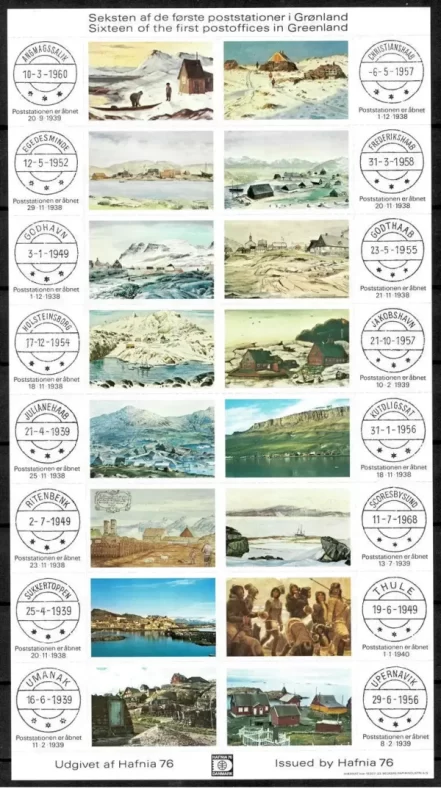Showing all 3 resultsSorted by latest
Showing all 3 resultsSorted by latest
Greenland’s postage stamps are a unique window into the island’s Arctic beauty, rich culture, and historical developments. As a remote territory with a strong connection to both Denmark and its indigenous Inuit population, Greenland’s stamps have attracted philatelists worldwide for their distinctive themes and beautiful designs. Here’s an overview of Greenland’s postage stamps:
Early Greenland Postage (Before 1938)
Before Greenland issued its own stamps, Danish stamps were used for postal services within the island. Greenland was a Danish colony, and up until the 20th century, no specific stamps were created for Greenland.
- Special Postmark: Even though Denmark’s stamps were used, they were often postmarked with the location “Grønland” (Greenland) to differentiate them.
- Parcel Post: In the early 20th century, there were Greenland-specific stamps used for parcel post. These stamps depicted a polar bear and were issued by the Royal Greenland Trading Department (KGH) for internal use.
The First Greenland Stamps (1938)
Greenland’s first official postage stamps were issued in 1938, and these marked the beginning of the island’s philatelic history.
- Designs: The first stamp series was known as the Polar Bear Series. It consisted of five stamps, all featuring a polar bear design, a symbol deeply connected to Greenland’s Arctic environment.
- Currency: These stamps were denominated in øre and kroner, the Danish currency, as Greenland was and remains part of the Kingdom of Denmark.
Post-WWII Stamps (1945-1950s)
- Return to Danish Control: During World War II, Greenland’s contact with Denmark was limited, and the island began issuing its own stamps. After the war, Greenland resumed using stamps that represented its cultural and natural heritage.
- First Commemorative Issue: In 1945, Greenland issued its first commemorative stamp to honour King Christian X’s 75th birthday, which was notable for breaking away from the early Polar Bear design.
Greenland Home Rule and Stamps (1979-2009)
- Home Rule Established: Greenland attained home rule in 1979, giving the island more autonomy, though it remained within the Danish Realm. Greenland began issuing its stamps under the administration of POST Greenland, which manages the country’s postal services to this day.
- Indigenous and Cultural Themes: Many stamps featured themes related to Greenlandic Inuit culture, including traditional kayaks, dog sledding, and hunting scenes. Other stamps depicted arctic wildlife and the natural beauty of the region.
- Cultural Heritage Series: A series of stamps depicted Greenlandic myths, folklore, and traditions, providing insight into the Inuit way of life.
Modern Greenland Stamps (2000s-Present)
In the 21st century, Greenland continues to issue stamps that celebrate both its modern society and traditional heritage. These stamps have a wide range of themes, including:
Key Themes in Modern Greenlandic Stamps
Nature and Wildlife:
-
- Polar Bears, whales, seals, and arctic birds are common subjects. Greenland’s rich biodiversity is a favorite topic for collectors, as its unique Arctic species attract global attention.
- Climate Change Awareness: Some modern stamps highlight Greenland’s changing environment, focusing on the effects of global warming and ice melt.Indigenous Culture:
- Inuit Art: Many stamps feature Greenlandic art, showcasing stone carvings, tupilaks (small carved figurines), and traditional crafts.
- Traditional Life: Inuit hunting scenes, fishing, kayaking, and other aspects of daily life are often depicted.Historical Events:
- Stamps commemorating significant events in Greenland’s modern history, such as the move toward greater autonomy under the Self-Government Act of 2009, have been issued.
- Explorers: Greenlandic and Danish explorers who contributed to Arctic exploration and knowledge of the region, such as Knud Rasmussen, are honored.Anniversaries and Special Events:
- Greenland issues stamps for important milestones, such as the anniversary of Greenlandic Home Rule or to celebrate international organizations.
- Cultural Festivals: Traditional festivals and Greenlandic celebrations are common themes.Joint Issues:
- Greenland has participated in joint stamp issues with other countries, particularly Denmark and the other Nordic nations. These collaborative issues often highlight shared Arctic heritage or historical connections between the nations.



